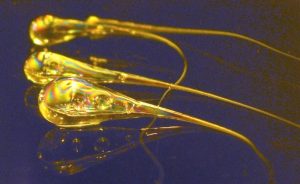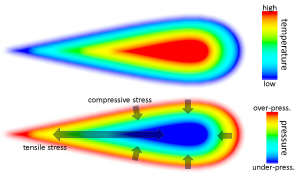Ordinary glass as it is used for windows can exhibit exceptional behaviors and even shred a rifle bullet to pieces, furthermore it can help to make car windows safer and to understand the inner processes in volcanos.
Key to all these fascinating properties are the so-called Prince Rupert’s Drops. These structures are solidified drops of glass, which are produced by letting a drop of molten glass fall into a bucket of water. The sudden shock caused by the massive temperature drop on the surface of the glass basically locks in the outer shape of the drop, preserving main body and tail. (Fig. 1) [1,2,3].

Fig. 1: Prince Rupert’s Drops. The thick main body with the long, thin tail is well visible (Copyright: public domain). [1]
To understand how this fascinating behavior is created, we have to have a closer look at how the drop is created. Everything starts with a drop of hot, molten glass, suddenly getting in contact with water. As mentioned, the outer layer of the drop immediately solidifies and locks in the characteristic drop or tear shape. The thin tail is created when the drop detaches from its origin (e.g. the glass rod) and starts falling and also gets locked into its shape when touching the water for the first time. While the outer layers are now already solid glass, the interior of the drop is still a hot liquid (Fig. 2 top). Consequently, this glass contracts while cooling down and starts pulling the solid outer layers inward, stressing them just like an arch bridge is stressed (compressive strain) and thereby stabilizes the structure. Along the axis of the drop, however, the strain is not compressive but tensile, because the shrinking material tries to pull along the tail.

Fig.2: Mechanism of creation of a Prince Rupert’s Drop. The hot, liquid interior of the drop compresses against the already hardened outer shell. The result is a highly strained structure (Copyright: CC-BY JUnQ). [4,5]
Finally, in its cooled state, the drop represents a system that exhibits extreme internal stresses. These stresses make the round shaped main body of the drop extremely resistant to external disruptions, whereas the tail constitutes a weak spot (Fig. 2 bottom). If the latter is now damaged in any way, the energy stored in the mechanical stress can be released and a mechanical failure front runs through the material, destroying more and more of it until the main body is shred to dust. This process can happen with a speed of around 1600m/s, just like an explosion, and it usually only ends with the pulverization of the whole drop. Thus, this is the secret of the Prince Rupert’s Drop; it is always experiencing extreme internal stress that makes the convex part so extremely stable (like an arch bridge) that even rifle bullets shatter on them.
So, we can ask whether this effect can be useful for anything. The answer is yes, indeed. Exactly the same principle is used in tempered glass like it is used e.g. in car windows. This glass does not shatter into sharp shards, but instead produces relatively smooth and small pieces and therefore is less harmful for the passengers of the car in case of an accident. Currently, Prince Robert’s Drops are even researched to understand better the quick cooling of volcanic lava under certain circumstances and therefore the inner processes within a volcano. Thus, all in all, these fascinating objects are full of wonders.
— Kai Litzius